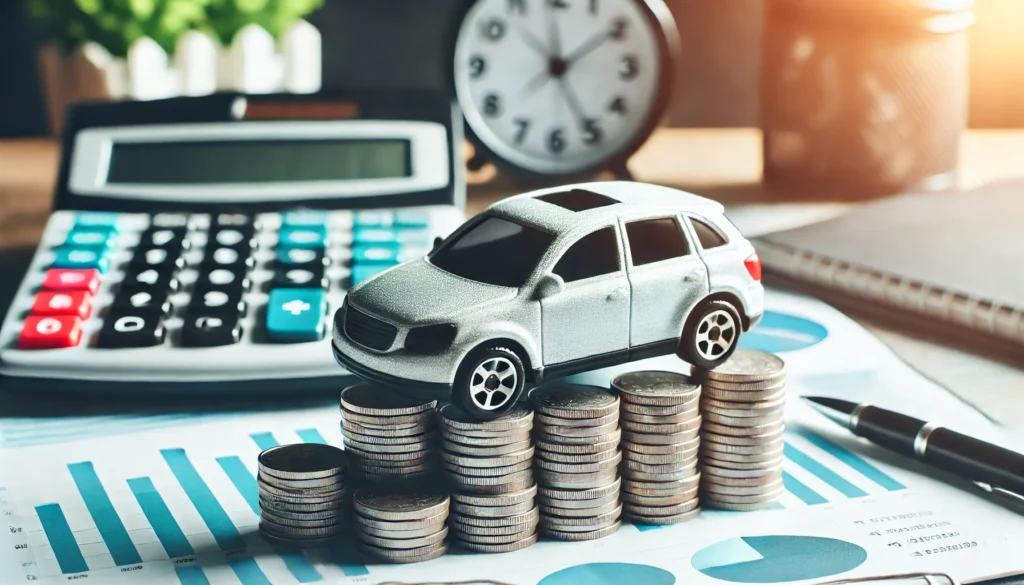Understanding the Financial Challenge of an $80,000 Car Purchase
Buying a car for $80,000 is no small financial undertaking, and managing such a significant car payment requires careful planning, sound budgeting, and strategic financing. Whether purchasing a luxury sedan, a high-performance sports car, or a premium SUV, an $80,000 car payment can have long-term financial implications if not approached with a well-thought-out plan. The decision to take on such a large car loan should not be made lightly, as it can impact other financial priorities, including savings, investments, and day-to-day cash flow management.
The key to managing a large auto payment effectively is understanding the full financial picture beyond just the monthly installment. Many car buyers focus only on whether they can afford the payment each month, neglecting the additional costs associated with ownership. Expenses such as insurance, maintenance, fuel, registration, and potential depreciation must all be factored into the overall cost of the vehicle. Even with a well-structured loan, failing to consider these variables can lead to financial strain down the road.
Another essential aspect to consider is the financing terms associated with an $80,000 car loan. Interest rates, loan durations, and creditworthiness all play a crucial role in determining the affordability of the payment. For instance, an 18 APR car loan can lead to significantly higher interest costs over time, making it critical to secure the most favorable loan terms possible. Utilizing tools like a $36,000 car loan calculator to compare financing scenarios can help prospective buyers assess different loan structures before making a commitment.
Beyond just managing the loan itself, understanding the opportunity cost of an $80,000 car payment is also important. While the allure of driving a high-end vehicle is strong, it is worth weighing whether the funds could be better utilized in other investments or financial endeavors. This article will explore the smartest budgeting and financing strategies for managing an $80,000 car payment while ensuring long-term financial stability.
You May Also Like: Smart Strategies for Buying a Car: How to Navigate Auto Loan Financial Options and Save Big
Breaking Down the True Cost of an $80,000 Car Loan
When financing a vehicle at this price point, understanding the total cost of borrowing is crucial. The sticker price of $80,000 is just the beginning, as interest, taxes, and fees can substantially increase the overall cost of ownership. Loan terms can vary widely, with repayment periods typically ranging from 36 to 84 months. Choosing the wrong financing option can result in paying far more than the car’s original price.
For example, consider an $80,000 car loan with a 6% interest rate over a 60-month term. In this scenario, the monthly payment would be approximately $1,546, with total interest paid over five years exceeding $12,700. However, with an 18 APR car loan, the same financing terms would result in significantly higher costs, driving the total interest paid above $40,000. This stark difference highlights the importance of securing a low-interest loan.
Additionally, longer loan terms may offer lower monthly payments but result in higher cumulative interest costs. While an 84-month loan might reduce monthly obligations to around $1,100, it can extend the repayment burden for seven years and add tens of thousands in interest. Comparing financing options using a $36,000 car loan calculator can illustrate the impact of different loan durations and rates on overall affordability.
Beyond financing, depreciation also plays a key role in the true cost of ownership. Luxury and high-performance vehicles often experience rapid depreciation, losing 40-50% of their value within the first five years. This means an $80,000 car could be worth just $40,000 or less after five years, particularly if it is not a limited-production model. Buyers should consider whether leasing or purchasing a pre-owned luxury vehicle might be a smarter financial decision.
Ultimately, understanding the long-term implications of an $80,000 car payment requires careful analysis of financing structures, interest costs, depreciation, and alternative options. Without this level of consideration, buyers may find themselves facing unexpected financial difficulties later in the ownership cycle.

Choosing the Right Financing for an $80,000 Car Payment
Securing the best financing for a large car purchase is essential to minimizing long-term costs. Several key factors, including interest rates, loan terms, and creditworthiness, influence the affordability of a car loan. Making the right financing choice can mean the difference between an easily manageable payment and a financial burden.
One of the first steps in securing an optimal loan is ensuring a strong credit score. Auto lenders base interest rates on creditworthiness, meaning borrowers with excellent credit (750+) are more likely to qualify for low-interest rates. For instance, while a buyer with excellent credit may secure a 4% interest rate on an $80,000 car loan, a borrower with a lower credit score may be offered an 18 APR car loan, significantly increasing the total cost of financing.
Loan term selection is another critical consideration. While 84-month financing may seem attractive due to its lower monthly payments, the long-term interest costs can be significantly higher. Instead, opting for a shorter-term loan—such as 48 or 60 months—can minimize interest expenses and build equity in the vehicle more quickly.
For buyers who prefer lower payments without the burden of extended interest accumulation, making a large down payment is a strategic option. A $36,000 car loan calculator can help determine how different down payment amounts affect monthly obligations. For example, a 20% down payment ($16,000) would reduce the loan principal to $64,000, lowering monthly costs and total interest paid.
Additionally, buyers should explore financing options beyond dealership offers. Banks, credit unions, and online lenders may provide more competitive interest rates, particularly for well-qualified borrowers. Pre-approved financing can also strengthen a buyer’s negotiating position at the dealership, potentially securing additional discounts.
Selecting the right financing structure ensures that an $80,000 car payment remains manageable while minimizing excess interest costs. Careful planning and comparison shopping can lead to substantial savings over the life of the loan.

Smart Budgeting Strategies for Managing a High Car Payment
Taking on an $80,000 car payment requires disciplined financial planning and effective budgeting. Without proper cash flow management, even well-intentioned buyers may find themselves struggling to keep up with payments while covering other essential expenses. Developing a comprehensive budgeting strategy ensures financial stability throughout the loan term.
One of the first steps in preparing for a large car payment is calculating the impact on monthly income. Financial experts typically recommend that car payments should not exceed 15% of gross monthly income. This means that to comfortably afford a $1,500 monthly car payment, a buyer should earn at least $10,000 per month before taxes. Buyers who exceed this threshold may find themselves overextended, sacrificing savings and discretionary spending.
Expense prioritization is another key component of smart budgeting. Car payments should be considered a fixed expense, meaning that discretionary spending—such as dining out, entertainment, and luxury purchases—may need to be adjusted to accommodate the payment. Creating a detailed monthly budget that accounts for all expenses, including insurance, maintenance, and potential repairs, ensures there are no unexpected financial shortfalls.
For buyers concerned about long-term affordability, building a financial cushion is crucial. An emergency fund with at least six months’ worth of expenses can help absorb unexpected costs, such as medical bills, job loss, or unforeseen vehicle repairs. Without such a buffer, a high car payment can become financially overwhelming during periods of economic uncertainty.
Another strategic budgeting approach involves supplementing income sources. Buyers who take on a large car payment may consider side hustles, freelance work, or passive income investments to offset the added financial responsibility. Diversifying income streams can make an $80,000 car loan more manageable while preserving savings and investment growth.
Proper budgeting ensures that a high car payment remains sustainable without compromising long-term financial goals. By structuring expenses wisely and maintaining financial discipline, buyers can enjoy their luxury vehicle without undue financial stress.

Frequently Asked Questions (FAQs): Managing an $80,000 Car Payment
1. What should I consider before committing to an $80,000 car payment?
Before committing to an $80,000 car payment, you should evaluate your financial situation, including your income stability, existing debt, and long-term financial goals. An expensive vehicle comes with additional costs, such as higher insurance premiums, increased maintenance expenses, and potential depreciation. It’s also essential to consider how the financing terms will affect your monthly budget, particularly if you are considering an 18 APR car loan, which could significantly increase your overall cost. Running different financing scenarios through a 36,000 car loan calculator can provide insight into how loan terms and interest rates impact your monthly payment and total cost. Carefully assessing all these factors will help you determine whether an $80,000 car payment is a financially responsible decision.
2. How much should I put down when financing an $80,000 car?
A substantial down payment can help reduce the financial burden of an $80,000 car payment by lowering the amount financed and decreasing interest costs. Experts typically recommend a minimum down payment of 20%, which would be $16,000 in this case. A larger down payment can also help you qualify for better loan terms, reducing the likelihood of needing an 18 APR car loan or other high-interest financing. If you plan to keep the car for a long time, a higher down payment can prevent you from being upside down on the loan, where you owe more than the car’s value. Using a 36,000 car loan calculator can help you determine how different down payment amounts affect your monthly payments.
3. How does an 18 APR car loan impact the total cost of an $80,000 car?
An 18 APR car loan significantly increases the total cost of financing an $80,000 car payment, making it far more expensive than a lower-interest loan. With an 18% interest rate, the total interest paid over a 60-month loan term can exceed $40,000, nearly doubling the cost of the vehicle. This makes it crucial to shop around for better financing options, such as credit union loans, dealer incentives, or lower-rate bank loans. If you have no other financing options, making additional principal payments can reduce the interest you pay over time. Before agreeing to high-interest financing, consider whether leasing or delaying your purchase to save for a larger down payment might be better alternatives.
4. What are the insurance costs for an $80,000 car?
Insurance for an $80,000 car payment is typically much higher than for an average vehicle due to the cost of replacement parts, repairs, and theft risk. Luxury and high-performance vehicles tend to have higher premiums, sometimes exceeding $200-$300 per month, depending on the make and model. Factors such as your driving history, location, and chosen coverage level also influence your premium. Bundling your car insurance with home or renters insurance and maintaining a clean driving record can help lower costs. Before purchasing, get insurance quotes to understand how coverage expenses will affect your overall budget.
5. How can I avoid being upside down on my car loan?
Being upside down on a car loan means owing more than the vehicle’s market value, a common risk with luxury cars and extended financing terms. To avoid this, make a larger down payment upfront and choose a shorter loan term whenever possible. Avoid rolling negative equity from previous car loans into your new loan, as this can worsen the financial burden. If possible, pay extra toward your principal each month, which can help you build equity in the car faster. Researching vehicles with strong resale value can also help minimize depreciation-related losses.
6. Is leasing a better option than financing for an $80,000 car?
Leasing can be a more attractive option for individuals who want to drive an expensive car without committing to the high monthly payments of ownership. Lease payments are typically lower than financing payments for the same vehicle, and leasing allows you to upgrade to a new model every few years. However, leases come with mileage restrictions and wear-and-tear fees that can add costs if you exceed the limits. If you prefer long-term ownership and want to avoid ongoing lease payments, financing may be the better option. Using a 36,000 car loan calculator can help you compare leasing and financing costs to determine the best choice.
7. How can I reduce my monthly car payment if I finance an $80,000 car?
There are several ways to reduce your monthly car payment while financing an $80,000 car payment. A larger down payment decreases the amount financed, leading to lower payments. Choosing a longer loan term, such as 72 or 84 months, can also lower monthly payments, though this will increase total interest costs. Refinancing to a lower interest rate later can help reduce payments, especially if your credit score improves. Additionally, making extra payments when possible can lower the overall loan balance and shorten the repayment period. Using a 36,000 car loan calculator can help you explore different scenarios to find the best payment structure.
8. What hidden costs should I budget for when purchasing an $80,000 car?
Beyond the $80,000 car payment, buyers must consider hidden costs such as taxes, registration fees, and dealer fees, which can add thousands to the purchase price. Maintenance and repair costs for luxury vehicles are typically higher than those for standard cars, as parts and labor can be more expensive. Fuel costs may also be higher, particularly if the car requires premium gasoline or has a lower fuel efficiency rating. Extended warranties and service plans can add additional costs but may provide financial protection against unexpected repairs. Factoring these expenses into your budget ensures you can comfortably afford ownership beyond just the monthly payment.
9. How does my credit score affect the loan terms for an $80,000 car?
Your credit score plays a crucial role in determining the interest rate and loan terms for an $80,000 car payment. A high credit score (above 700) qualifies borrowers for the best interest rates, while lower scores may result in high-interest loans, such as an 18 APR car loan. If your credit score is below 650, lenders may require a larger down payment or offer less favorable terms. Improving your credit score before applying—by paying down debt, making on-time payments, and reducing credit utilization—can lead to significant savings. Running different scenarios through a 36,000 car loan calculator can help you understand how your credit score impacts financing costs.
10. What are the best alternatives to an 18 APR car loan?
If you are offered an 18 APR car loan, it’s worth exploring other financing options to reduce your borrowing costs. Credit unions often offer lower interest rates than traditional banks, especially for members with strong credit histories. Dealer financing promotions, such as 0% APR offers, can be a better option if you qualify. Personal loans from banks or online lenders may provide better rates, depending on your creditworthiness. Additionally, delaying your purchase to save for a larger down payment or improve your credit score can help you secure a more favorable loan. Running different numbers through a 36,000 car loan calculator can help you compare alternative financing options.
Conclusion: Is an $80,000 Car Payment the Right Financial Move?
An $80,000 car payment represents a significant financial commitment that requires careful consideration. While luxury and high-performance vehicles offer unparalleled driving experiences, the long-term financial impact of such a purchase must be thoroughly evaluated. By understanding the total cost of ownership, choosing the best financing strategy, and implementing sound budgeting techniques, buyers can make informed decisions that align with their financial goals.
Securing the right loan, minimizing interest costs, and maintaining a disciplined financial approach ensures that an $80,000 car purchase remains a responsible investment. Buyers who take proactive steps—such as improving credit scores, making sizable down payments, and considering alternative financing options—can successfully manage their auto loan while maintaining financial stability.
Ultimately, the decision to take on a large car payment should align with long-term wealth-building strategies, ensuring that luxury and financial security go hand in hand.
luxury car financing, high-end vehicle loans, $80,000 car payment, smart car budgeting, auto loan interest rates, 18 APR car loan, car loan repayment strategies, vehicle depreciation, down payment strategies, car lease vs buy, high-value car insurance, refinancing auto loans, financial planning for car purchases, monthly car payment management, certified pre-owned luxury cars, hidden car ownership costs, debt-to-income ratio, car loan calculator, negative equity risks, affordable luxury car financing
Further Reading:
Is your car payment too expensive for your monthly budget?
How to Budget for Your Car Finance Payments
How Much Should My Car Payment Be?





